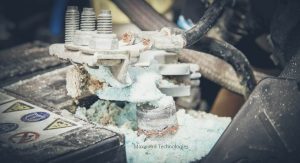The cause of lithium battery explosion
Recently, there have been more and more incidents about lithium battery explosion. Let’s discuss why lithium batteries explode. Lithium batteries, if you are not a person in the battery industry, you may not know it, but as a normal person living on the earth, you cannot escape the range of lithium batteries. Because in daily life, lithium batteries can be seen almost everywhere, from electric cars to computer motherboard batteries. But what lithium batteries can let you know maybe that lithium batteries often cause some safety accidents. The most impressive thing is the explosion and fire caused by lithium batteries.
What is a lithium battery?

Principle of Lithium-Ion Battery. Lithium-ion battery is mainly composed of a positive electrode, the negative electrode, separator, and electrolyte. The positive and negative electrode layers are tightly rolled together, and the layers are separated by insulators. The positive and negative electrodes are immersed in the electrolyte. Taking cylindrical batteries and prismatic batteries as examples below, the positive and negative electrodes of the lithium-ion battery structure composed of two different lithium intercalation compounds respectively. Cathode materials mainly include transition metal oxides, metal oxides, and metal sulfides. The commonly used cathode materials in commercial lithium-ion batteries are transition metal oxides. The most widely used anode materials include inorganic non-metal materials, metal materials, metal-non-metal composite materials, and metal oxides. Lithium iron phosphate anode and cathode materials are coated on conductive materials to form electrodes, and the electrode materials determine the voltage and capacity of the battery. As an important part of lithium-ion batteries, electrolyte plays an important role in the transmission of current during battery charging and discharging.

To prevent short circuiting of the positive and negative materials immersed in the electrolyte due to mutual contact, the positive and negative materials are separated by a polyolefin separator. A Lithium-ion secondary battery is a battery with poor lithium-ion concentration. When charging, Li is taken out from the positive electrode and inserted into the negative electrode through the electrolyte. The negative electrode is in a lithium-rich state and the positive electrode is in a lithium-poor state. The electronic compensation charge is supplied to the carbon negative electrode by an external circuit to ensure the balance of the charge. Under normal charge and discharge conditions, lithium ions are inserted and removed between the layered carbon material and the layered structure oxide, which usually only causes the change of the material layer spacing without destroying their crystal structure.
Why did the lithium battery explode?

Knowing the working and construction principles of lithium batteries, we can easily know why lithium batteries cause explosions. The charging and discharging of lithium “dendrite” growth batteries are the transfer of lithium ions back and forth. Generally speaking, lithium will be embedded in the interlayer structure. However, due to the uncertainty of growth, lithium may grow on the surface of the electrode. The growth layer has a thorn-like structure like a branch, which can damage the internal diaphragm of the battery and cause a short circuit inside the battery, therefore increase the risk of lithium battery explosion.

If the battery is defective, metal particles are connected to the positive and negative electrodes through the insulating layer of the battery, changing the direction of the current, generating a lot of heat, degrading the internal materials, causing the chemical reaction to losing control, and releasing more heat to ignite the battery components. The battery is overcharged. Our current battery has a protection system that feedbacks the battery voltage at any time to prevent overcharge. This may cause damage to the battery protection system or battery charger during overcharging. When overcharging occurs, the lithium ions left in the cathode material continue to be removed and embedded in the negative electrode material.
Battery short-circuit and overcharging will bring lithium battery explosion

There are two important causes of lithium battery explosion, one is a short circuit and the other is overcharge. The short circuit is easy to understand, that is, the positive and negative poles of the battery are in direct contact. First, in a normal short period time, the heat generated by a short circuit in a small area is very small, and it will not cause thermal runaway. An explosion-proof valve is used in the design of the cell itself, which means that when the internal pressure of the cell exceeds a certain value, the explosion-proof valve will be opened and the heat will quickly dissipate. The second is that the battery charging equipment in normal use is protected from overcharge, and when the battery voltage reaches a certain value, it will stop charging. The shell of the third cell itself is a steel shell, which has good protection.In view of the previous remarks, it is recommended that everyone not overcharge and protect the battery.











